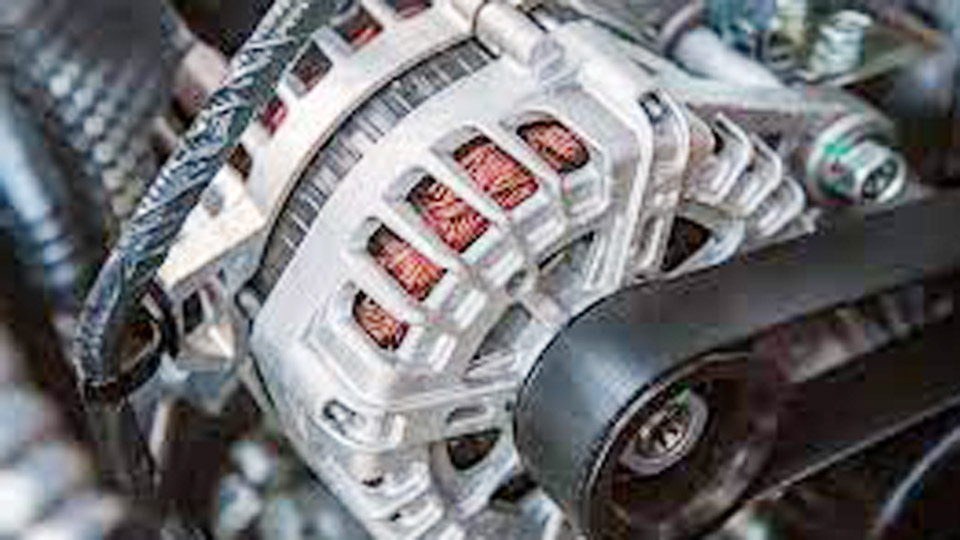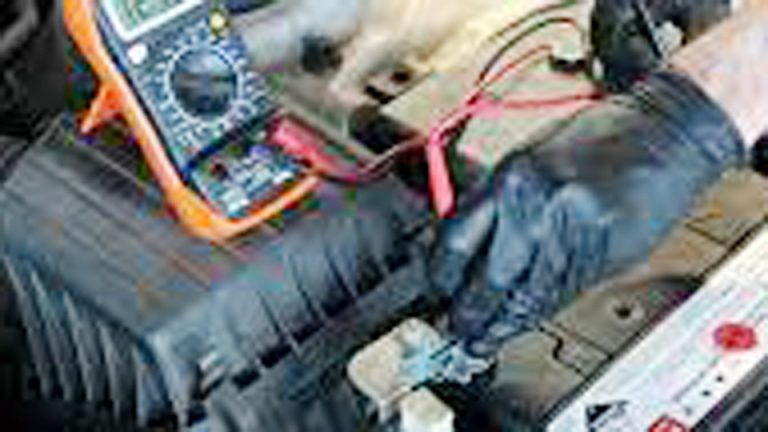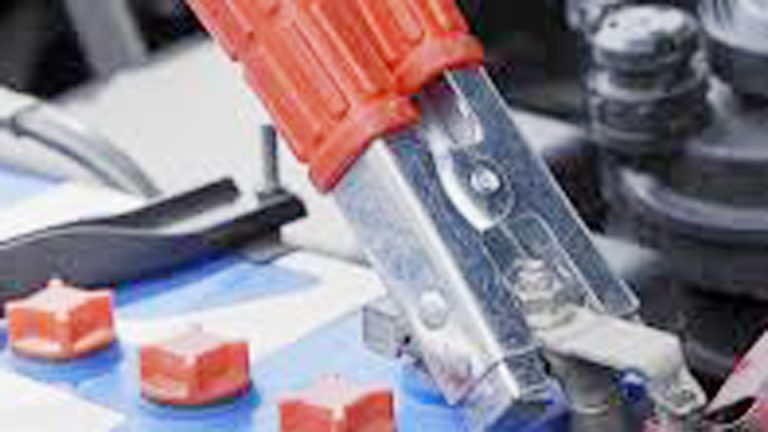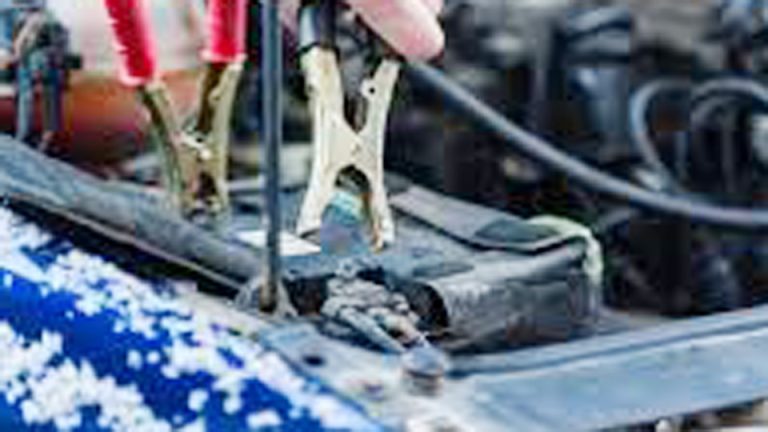The alternator is one of those parts most drivers don’t think about until something goes wrong—like a dead battery or flickering headlights. If you’ve ever wondered What Is the Function of the Alternator in a Car Engine, here’s the simple truth: it’s the powerhouse of your car’s electrical system. While the battery gets the engine started, it’s the alternator that keeps everything running once you’re on the road. It generates electricity to power the lights, radio, AC, and all the modern electronics in your car, while also keeping the battery charged.
From a mechanic’s perspective, I’ve seen plenty of cars come in with strange issues—dim dashboard lights, weak power windows, or constant jump-starts—that all traced back to a failing alternator. Without it, your car would only run for as long as the battery had charge, which usually isn’t far. That’s why the alternator is not just a convenience—it’s essential for reliability and safety every time you drive.

Image by howstuffworks
Understanding the Alternator: The Heart of Your Car’s Charging System
If you’re a DIYer tinkering in your garage or an auto student piecing together how engines really run, knowing the alternator’s role is key. I’ve replaced hundreds of these over the years, from compact sedans to heavy-duty trucks, and every time, it reminds me why this part is non-negotiable for modern vehicles.
What Exactly Does the Alternator Do?
At its core, the alternator is an electrical generator mounted on your engine block, driven by a belt connected to the crankshaft. As the engine spins, it turns the alternator’s rotor inside a stator, creating alternating current (AC) through electromagnetic induction—yeah, that high school physics stuff actually pays off. A built-in rectifier then converts that AC to direct current (DC), which your car’s battery and electronics need. This powers everything from headlights and AC to the fuel injectors and infotainment system while simultaneously recharging the battery.
In my experience, folks often confuse it with the starter motor, but they’re opposites: the starter gets the engine going, while the alternator keeps it sustained. On a typical V6 like in a Ford Explorer, the alternator might output 100-150 amps at idle, ramping up to 200+ under load. That’s crucial because cars today guzzle power—think heated seats, GPS, and those fancy LED lights. Without the alternator doing its job, you’d drain the battery in 30 minutes flat.
Why the Alternator Matters for Safety, Performance, and Your Wallet
Skip the alternator, and you’re risking more than a dead battery. Safety-wise, it ensures your brakes, airbags, and stability control stay powered—I’ve seen dimming lights lead to near-misses at night. Performance suffers too; a weak alternator causes sluggish acceleration as the engine computer compensates for voltage drops. Fuel efficiency? It ties in indirectly—electrical loads pull from the engine, so a failing unit makes your truck guzzle more gas on long hauls.
From a cost angle, ignoring it leads to pricier fixes. A new battery might run $150, but if the alternator’s shot, you’ll replace it again soon. Reliability is huge in the US, where we log serious miles—think cross-country road trips in a Subaru Outback. I’ve advised countless customers: Treat the alternator right, and it’ll last 100,000 miles easy. Neglect it, and you’re towing your Chevy Silverado to the shop sooner than you’d like.
Spotting Trouble: Common Problems with Car Alternators
One of the best parts of my job is diagnosing issues before they strand someone. Alternators don’t fail overnight; they give warning signs if you’re paying attention. I’ve pulled apart enough to know the usual culprits, and sharing this can save you a roadside headache.
Signs Your Alternator is on the Fritz
The classic red flag? That battery warning light on your dash—it’s not just for show. It glows when voltage drops below 13.5V, meaning the alternator isn’t charging properly. I’ve had customers roll in with flickering headlights or accessories that cut out randomly; that’s the alternator struggling to keep up.
Other tells: A whining noise from under the hood, like a high-pitched scream when accelerating—that’s often worn bearings inside. Or your battery dying despite being new; I once fixed a guy’s Jeep Wrangler where the alternator’s diode had fried, leaking current back to the battery. Dim interior lights, slow power windows, or even a sulfur smell from overworked wiring? All point here. In electric-heavy rides like a Tesla Model 3 knockoff (wait, no, we’re talking gas engines), but seriously, modern Fords with all the tech amplify these issues.
Diagnosing Alternator Failure Like a Pro
Don’t guess—test it. Grab a multimeter from AutoZone (they’re under $20) and check voltage at the battery terminals with the engine running: Should be 13.8-14.4V. Below 13V? Suspect the alternator. Load-test it too—turn on headlights and AC; voltage shouldn’t dip much. I’ve taught apprentices this trick: Use a clamp meter on the output wire for amp draw. If it’s low, the brushes or regulator might be toast.
Common failure modes? Heat and age. In hot US states like Texas, alternators cook from constant belt tension. Water ingress in flooded underhoods (hello, Florida hurricanes) corrodes internals. And don’t get me started on cheap rebuilds—I’ve seen voltage regulators fail prematurely, spiking power and frying ECUs.
When and Why You Need to Replace Your Alternator
Replacement isn’t always urgent, but ignoring it escalates problems. I’ve swapped them in everything from daily drivers to weekend warriors, and timing it right keeps costs down.
Factors That Trigger Alternator Replacement
Mileage is a big one—expect 80,000-150,000 miles on a good unit, but harsh conditions shave that. If diagnostics confirm low output or internal shorts, it’s time. Why replace? A failing alternator stresses the battery, belts, and wiring, leading to cascading failures. In my shop, we see it most in high-mileage vehicles like the Honda Accord or Toyota Camry, where original parts wear thin.
Also, upgrades matter. If you’re adding winches to your Ram 1500 for off-roading, stock alternators can’t handle the extra draw—I’ve installed high-output ones to prevent blackouts mid-trail.
Assessing If It’s Time for a New One
Start with a belt inspection: Cracked or loose serpentine belts slip, mimicking alternator issues. I always check tensioners first—easy fix for $50 vs. $300 for the alternator. If the part tests bad, weigh symptoms against costs. A pro diagnosis runs $50-100 at places like Pep Boys, worth it to avoid unnecessary swaps.
OEM vs Aftermarket Alternators: Making the Smart Choice
This is where choices get real. As someone who’s bolted in both types across US roads, I can tell you: It’s not one-size-fits-all. OEM shines for fit, but aftermarket wins on price and options.
Breaking Down OEM Alternators
OEM (Original Equipment Manufacturer) means the exact part from your car’s maker, like Denso for Toyotas or Bosch for VWs. Pros: Perfect compatibility—no weird wiring hassles—and often a longer warranty (up to 3 years). They match factory specs, so idle output is spot-on, crucial for sensitive electronics in a 2025 Chevy Equinox.
Cons? Pricey—$200-400 for a mid-size sedan, plus labor. Availability can lag for older models like a ’90s Mustang. But in my experience, they last longest; I put an OEM in a customer’s Prius that hit 200k without a hiccup.
The Aftermarket Landscape: Brands, Pros, and Cons
Aftermarket opens doors—brands like ACDelco (GM staple), Remy, or Oracle deliver solid rebuilds. Pros: Cheaper ($100-250), quicker shipping via RockAuto or Advance Auto Parts, and high-amp options for modded rides. I’ve used NAPA’s house brand on budget jobs; they punch above weight for daily use.
Downsides: Quality varies. Some no-names fail fast due to subpar rectifiers. Noise or vibration? Common in off-brand pulley designs. For US trucks like the Ford F-250, stick to proven lines—I’ve seen generic ones overheat under diesel loads.
Here’s a quick comparison table based on what I’ve installed in common US vehicles:
| Aspect | OEM (e.g., Denso for Honda) | Aftermarket (e.g., ACDelco or Remy) |
|---|---|---|
| Price Range | $250-450 | $120-300 |
| Warranty | 1-3 years, unlimited miles | 1-2 years, often mileage-limited |
| Compatibility | Perfect fit, no mods needed | Generally good, but check specs |
| Output Quality | Factory-spec reliability | Varies; high-end matches OEM |
| Best For | Warranty claims, luxury cars | Budget fixes, high-mileage trucks |
| Lifespan | 100k+ miles | 80k-120k miles |
For a Subaru Forester in snowy Midwest winters, go aftermarket high-output if you run accessories—OEM might not cut it.
Spotting Genuine vs Fake Parts in the US Market
Fakes flood eBay and shady sites—look for holograms or part numbers matching the manufacturer’s site. Genuine Bosch has a specific weight and finish; counterfeits feel light and rattle. Buy from trusted spots like O’Reilly Auto Parts or dealer networks. I’ve busted fakes by testing output—knockoffs spike voltage erratically, risking electronics.
Hands-On Guide: Replacing Your Car Alternator Step by Step
I’ve done this swap on everything from cramped engine bays in Minis to spacious ones in Tahoes. It’s doable DIY if you’re handy, but safety first—disconnect the battery to avoid shorts.
Tools and Prep You’ll Need
Essentials: Socket set (10-18mm), belt tensioner tool, multimeter, and jack stands. For US cars, a serpentine belt tool kit ($20 at Harbor Freight) is gold. Wear gloves—grease flies everywhere. Park on level ground, engine off and cool.
Step-by-Step Installation Process
Safety and Disconnect: Chock wheels, disconnect negative battery cable. I always tape it back to prevent accidental contact—zaps aren’t fun.
Access the Alternator: Loosen the serpentine belt via the tensioner pulley. On a typical GM 3.6L V6, it’s front-right; consult your Haynes manual for exact spot. Remove any plastic covers—I’ve snapped clips rushing this.
Unbolt and Remove: Four bolts usually—two mounting, one adjusting. Wiggle it out; tight bays like in a VW Jetta need patience. Disconnect the wiring harness and B+ cable last—label if needed.
Install the New One: Reverse it. Torque bolts to spec (around 18-25 ft-lbs; check service manual). Reconnect wires securely—loose grounds cause no-charge issues I’ve chased for hours.
Belt and Test: Route the belt correctly (diagrams on the hood or online). Reconnect battery, start engine, rev to 2,000 RPM, and multimeter-check voltage. If it’s good, you’re golden.
Time? 1-2 hours for pros, 3-4 for DIY. Common mistake: Forgetting to reset the ECU—leads to check engine lights. In my garage, we bleed the system post-install to clear air, but that’s overkill for most.
Safety note: If it’s a belt-driven setup, watch for spinning parts. And for hybrids like the Ford Escape, extra caution around high-voltage bits—leave that to pros.
Maintenance Tips to Keep Your Alternator Running Strong
Prevention beats cure. I’ve extended lives by simple habits, saving customers big.
Daily and Routine Checks
Inspect belts monthly—cracks mean slippage. Clean terminals with baking soda mix; corrosion kills output. In dusty areas like the Southwest, blow out the alternator vents yearly. I tell truck owners: Monitor voltage gauge if equipped—drops signal early wear.
Avoiding Common Pitfalls
Overloading? Ditch unnecessary accessories. Jump-starting wrong (positive first) fries diodes—always negative last. For salty roads in the Northeast, rinse undercarriage post-winter. And upgrades: If modding your Mustang GT, pair with a beefier battery.
Best practice: Annual load test at a shop. Costs little, catches issues early.
Garage Tales: Real Stories from Fixing Alternators
Nothing beats stories to make this real. Take old man Jenkins with his ’05 Silverado—whining alternator stranded him at a gas station. Turned out, a loose belt from a DIY tune-up. We swapped it for a Remy unit; he’s still hauling trailers at 250k miles.
Or the young mom in her CR-V: Lights dimming scared her kids. Quick diag showed a bad regulator. OEM fix ran $350, but she learned to check fuses first—saved her future headaches. And me? Early on, I botched a Civic install, stripping a bolt. Lesson: Use penetrating oil on rusty trucks. These moments build the know-how that keeps us driving safe.
Conclusion: Empowering You to Handle Your Car’s Alternator
The alternator’s function in your car engine is all about sustaining power for a seamless drive—charging the battery, fueling electronics, and preventing breakdowns that could ruin your day. From my years turning wrenches, the key takeaway is proactive care: Spot signs early, choose quality parts wisely, and maintain religiously. Whether OEM for peace of mind or aftermarket for value, match it to your ride’s needs—US staples like the F-150 demand durability.
To make smarter decisions, always diag before buying, source from reputable spots, and DIY if comfy, but don’t skimp on tools. When installing, double-check belt routing with a mirror—I’ve seen misalignment cause overheating in under 500 miles. Drive on, stay charged, and keep that engine purring.
FAQ: Common Alternator Questions from the Garage
How Long Does a Car Alternator Last?
In real-world use, expect 7-10 years or 100,000-150,000 miles, depending on driving. Harsh conditions like stop-go city traffic in LA cut it short, but regular checks push it further. I’ve seen well-maintained ones hit 200k easy.
Can a Bad Alternator Drain Your Battery Overnight?
Absolutely— if diodes fail, it backfeeds current, draining even when off. Test by disconnecting the alternator cable; if the battery holds charge, that’s your culprit. Common in older Dodges I’ve fixed.
Is It Worth Replacing the Alternator Myself?
For handy folks with basic tools, yes—saves $200-400 in labor. But if your bay’s tight like in an Accord, or you’re unsure, shop it out. Safety’s key; I’ve guided many through it without issues.
What Happens If You Drive with a Failing Alternator?
Short-term, you’ll limp on battery power—lights dim, engine may stall. Long-term, it fries the battery and wiring. Don’t risk it; tow if needed. Happened to a buddy’s Tacoma on a desert run—lesson learned.
Are High-Output Alternators Necessary for Stock Cars?
Not usually—stock handles daily loads fine. But for audio systems or off-road lights on a Jeep Wrangler, upgrade to 200+ amps. Just ensure your wiring supports it to avoid fires.



